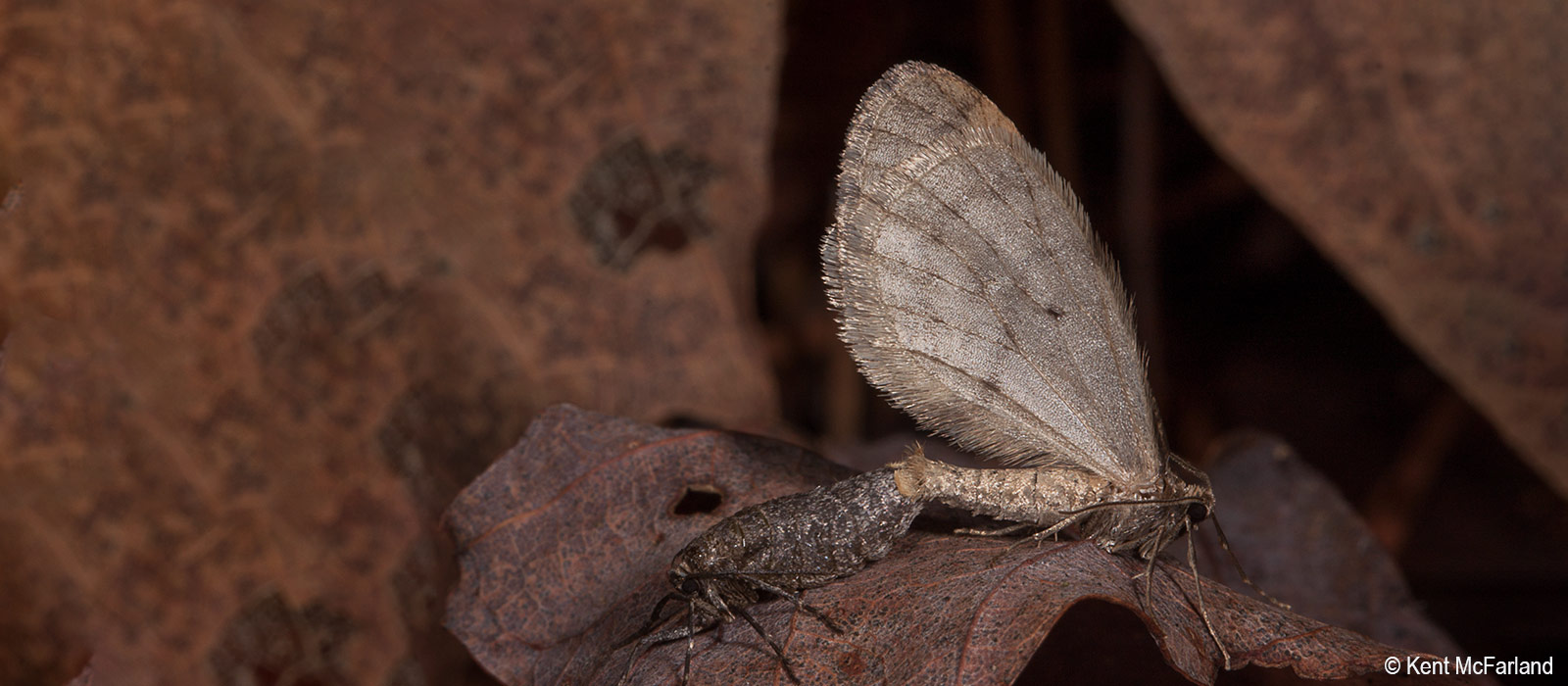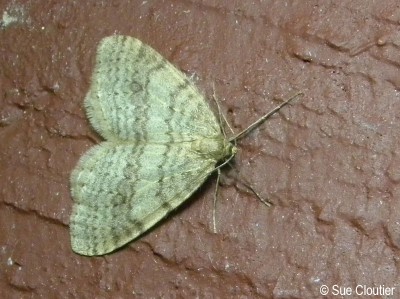
Fertility and Flight
The Sacrifices of a Winter Moth
In the angled light of November, a moth crossed my path through barren woods the other day. Yeah, a moth, in the cold — a lesson in adaptation, fertility, and feminine sacrifice going by the name Bruce Spanworm.
 As a caterpillar, Bruce Spanworm (Operophtera bruceata) is one of the inchworms, a member of the large moth family called Geometridae (which means “earth-measuring”).* As an adult, Brucie is not particularly showy. His forewings, about 1.5 inches across, are dull gray with dark flecking, and its hindwings are even less dramatic. But who needs pizzazz when you’ve got the audacity to fly around in winter.
As a caterpillar, Bruce Spanworm (Operophtera bruceata) is one of the inchworms, a member of the large moth family called Geometridae (which means “earth-measuring”).* As an adult, Brucie is not particularly showy. His forewings, about 1.5 inches across, are dull gray with dark flecking, and its hindwings are even less dramatic. But who needs pizzazz when you’ve got the audacity to fly around in winter.
By now virtually all our moths and butterflies no longer live as gossamer-winged adults. Instead, they’re overwintering as either eggs, caterpillars, or pupae (a cocoon in the case of a moth). But walk through deciduous woods in November, and Bruce Spanworm or a relative called Fall Cankerworm (Alsophila pometaria) will most likely be your companion, even fluttering among snowflakes into December. These moths are also called Hunter’s Moths because they fly in the company of deer hunters.
We normally think of moths as ectothermic (or, more commonly, by the confusing term “cold-blooded”), which means they depend on environmental heat sources in order to fire up their metabolism, including their flight muscles. It’s the reason most insects fly in summer.
So how is it that Bruce Spanworm is such a hearty iconoclast? Why does it fly when warmth and solar energy are in such short supply? Well, for one thing, insectivorous birds are also in short supply, most having left us by now for the tropics. So a moth that can fly when predators are fewer can presumably go about its business breeding (more on that later) with greater success.
Yet a cold-weather sex drive and avoiding getting eaten, while certainly important, aren’t enough for a moth to take flight in freezing temperatures. As it turns out, the male Bruce Spanworm, while dull in appearance, is buff; he’s a muscle-man. And his flight muscles perform in the cold.
One study by James Marden, a biologist at Pennsylvania State University, published in 1995 in The Journal of Experimental Biology, determined that Bruce Spanworm’s flight muscles can generate greater force at lower temperatures than a comparative summer-flying moth.
But physique also plays a role. Bruce Spanworm has more muscle mass as a percentage of his total body weight compared to the summertime moth used in the study. Sure, he may be small, but like a welterweight boxer, ounce-for-ounce he’s formidable. Perhaps more importantly, Bruce has a low wing-loading, which is basically the total weight of the moth divided by the surface area of his wings. Our pal Bruce gets a lot of lift for each flap. This lowers the energy he needs to flutter around with the hunters in November, a crucial adaptation for an insect that relies on solar energy for flight. (As a Vermonter, I’ll point out that Vermont biologist Bernd Heinrich, my office mate at the University of Vermont, did amazing work on insect thermoregulation, including a 1985 paper on winter-flying moths. Bernd has contributed greatly to our knowledge of Bruce Spanworm and the thermodynamics of insects in general.)
None of this wing analysis applies to the females … because females lack wings.
None of this wing analysis applies to females. That’s because the females don’t fly. They don’t fly because they lack wings. Females, full of eggs, simply sit there on the trunks of trees and waft pheromones, chemical attractants, into the air to lure males for mating. In fact, one of the best ways to locate a female Bruce Spanworm is to look for a cluster of males fluttering over a spot on the tree trunk. It is a certain sign the boys are competing for a copulation with a flightless female. My pal Kent McFarland caught a pair in the act (pictured in the banner above).
The female Bruce Spanworm is essentially an egg vessel; her body cavity is packed with eggs – an average of 143, according to Marden’s study – rather than large internal organs or tissue. Were she to regain the ability to fly, to develop wings and wing muscles, a female Bruce Spanworm might have to lose some of her eggs. She can’t get something for nothing. She’s given up wings for greater fecundity – a greater ability to reproduce.
In the course of her evolution, the female Bruce Spanworm has traded flight for fertility. To consider it from another angle, what might you trade in order to take flight?
* As it turns out, some of these moths might also be another member of the genus, Operophtera brumata; it’s tough to tell them apart.
Here’s my short indie film about all this (recorded November 9, 2010) called “Walking with Moths.”
Reference:
Marden, J.H. 1995. Evolutionary adaptation of contractile performance in muscle of ectothermic winter-flying moths. The Journal of Experimental Biology. 198, 2087–2094.

Thanks, Remy. And I did indeed get a ride home that night. 🙂
Wonderful video, thanks. I hope you got a ride home!
Ha! Thanks, Jay! Or some theme song from Mothra! 🙂
Awesome job Bryan, I missed the Springsteen soundtrack though. Was it “Blinded by the Light” Enjoy getting your emails and hope to see more videos.
Thanks, Martha. Yeah, look for a cluster of males in flight near the truck of a tree. You might find a cryptic female. Keep me posted!
Hey, Bryan, entertaining video. You always take that extra step to bring science into our home computer. thank you!
I saw several of these guys on the trails in Merck Forest (Rupert) on Sat. Nov 8th. So pretty and dainty flying above the thicket of leaves on the trails. Next time I encounter them, I’ll know to look for the female!
Glad you’re seeing them, Julie. Funny thing: I didn’t see that many in Hubbard Park here in Montpelier today. But they’re most certainly around this winter.
Hi Walter,
Nope, just a headlamp and a hand-held point-and-shoot! I might need to get one of those GoPro cameras, however. They seem fun.
How did you shoot video while walking and carrying a flashlight? I’m guessing you used a GoPro camera, right?
Very interesting!! I have seen quite a few the past few days and thought ” how odd” apparently not!! Thanks Bryan!
Thanks, Julia! Glad you made it to the end of that video. I’m seeing the moths during the day in Hubbard Park. Next few days should be great for them.
Wow–I’ve been seeing these little critters around–now I know so much more about them! Still trying to get undizzified from the film–the credits gave me a good laugh. 🙂